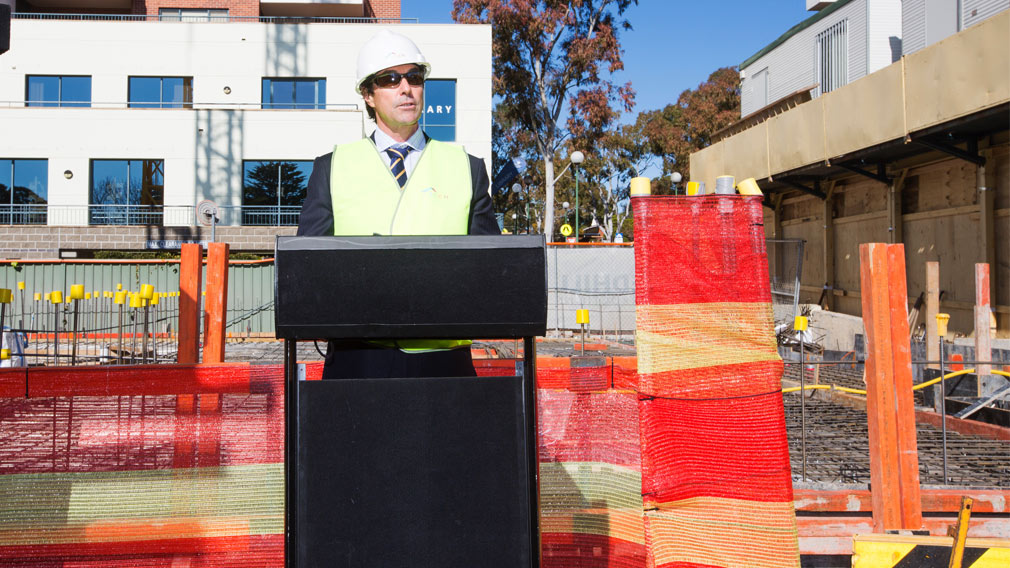Unified affordable housing policy will woo more capital

Jon Ross, at the site of SGCH's Belmont Street construction, financed through one of the largest affordable housing finance facilities to date. (SGCH)
Access to social and affordable housing is a core part of our social fabric.
Increasing rents and lack of affordable housing creates a huge divide in our community, particularly in markets such as Sydney and Melbourne where prices have risen strongly in the past five years.
This issue is only getting worse – particularly the case for people earning low to moderate incomes – and prompting much debate and research, including the Committee for Economic Development of Australia’s housing report last week. It’s no surprise given the gravity of the issue. For example, the waiting list for social housing in NSW alone is 60,000.
Westpac has committed more than $1.2 billion in funding to the sector to date and is keen to do more, particularly on a larger scale.
But in order to commit the vast sums of money required to overcome this issue, the private sector needs an over-arching, coordinated policy framework, inclusive of relevant subsidies and a consistent pipeline. Doing so will go a long way in driving large scale finance like we have seen in the UK.
Because social and affordable dwelling rental yields are well below private market rates, its delivery is not commercially viable without government subsidies. Governments at local, state and federal level are all supportive and there is bi-partisan support to address this issue.
However, despite state initiatives moving the market in the right direction, each state is going about it in different ways. In the absence of a broad policy framework, opportunities have been approached on a project-by-project basis, resulting in bespoke solutions that have been difficult to replicate at scale.
For example, Westpac’s biggest single lend is a $61 million facility for St George Community Housing, which is facilitating construction of up to 285 dwellings across Sydney.
The transaction involved developing an innovative structure, monetising a portfolio of existing housing stock from available and projected cashflows to support an appropriate level of debt for further construction.
The challenge is replicating this transaction in the market.
That said, there are positive signs emerging for the sector. The NSW government last year announced its Futures Directions for Social Housing in NSW strategy report giving a clear guideline of the government’s objectives and key initiatives over the next decade, which in turn delivers the private sector a level of clarity on objectives and potential opportunities to invest sustainably over this time.
One of the key initiatives was the $1.1bn Social and Affordable Housing Fund. Under this initiative, NSW Treasury Corporation invests those funds and uses the returns, to provide an annuity-style subsidy payment to support the development and ongoing management of some 2200 social and affordable housing dwellings.
Another key pillar of the Future Directions paper is the Communities Plus program, under which, via competitive tender, state land is subsidised for the development of social and affordable housing dwellings.
Queensland and Victorian governments have also recently announced moves to drive private sector engagement and commitment in their social and affordable housing initiatives.
In Western Australia, initiatives have included Keystart, a lending entity established by the state government that provides a shared equity product, offering a potential gateway for people to enter the housing market and transition from affordable housing tenancy. A similar program exists in South Australia via the Homestart lending business.
At a federal level in Australia, Treasurer Scott Morrison announced various policy measures in the 2017 budget related to social and affordable housing including the creation of the National Housing Finance and Investment Corporation (NHFIC), a new entity that will source private sector funds for on-lending to affordable housing providers to finance rental housing development.
The Treasurer also proposed reform to the primary federal-state funding arrangements for social and affordable housing, looking to introduce more accountability at a state level to drive more efficient deployment of funds to the social and affordable housing sector.
While we are definitely heading in the right direction, these initiatives are focussed on smaller patches across each state.
A unified policy framework that gives the sector structure at a national level is essential. In turn, this gives the private sector confidence and an investment model, around which a pipeline of opportunities can be built over the medium to longer term.
A good example is the evolution of the UK market. The largest Community Housing Providers in Australia own and manage 6-9,000 properties with annual turnover in the order of $50m. By comparison the largest housing associations in the UK own and manage more than 50,000 properties and generate annual gross turnover in excess of £500m ($811m) per annum.
From a financing perspective, the UK housing associations are supported by more than £40bn in bank debt and bond issuance in excess of £4bn.
Until this confidence has been established through a united policy front in Australia, private sector resources, capital and expertise will only be deployed in smaller pockets, without the scale to tackle these challenges head on.


